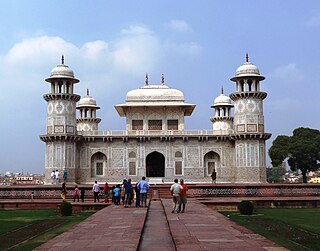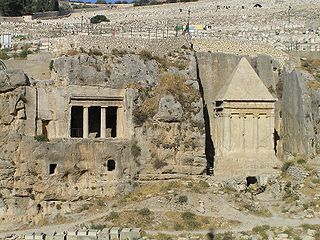
A tomb is a repository for the remains of the dead. It is generally any structurally enclosed interment space or burial chamber, of varying sizes. Placing a corpse into a tomb can be called immurement, and is a method of final disposition, as an alternative to for example cremation or burial.

Rock-cut tombs are a form of burial and interment chamber used in ancient Israel. Cut into the landscapes surrounding ancient Judean cities, their design ranges from single chambered, with simple square or rectangular layouts, to multi-chambered with more complex designs. Almost all burial chambers contain a platform for primary burial and an ossuary or other receptacle for secondary burial. There is debate on if these tombs were originally intended for secondary burials, or if that practice arose later. The use of rock-cut cave tombs in the region began in the early Canaanite period, from 3100–2900 BCE. The custom lapsed a millennium, however, before reemerging in the earliest Israelite tombs, dating to the 9th century BCE in Jerusalem. The use of rock-cut tombs reached its peak in the 7th and 8th centuries BCE, before rapidly declining and eventually falling out of use in the 6th century BCE in some regions. Use of the tombs has been recorded as recently as the Late Roman Period around the 3rd century CE. The use of such tombs was generally reserved for the middle- and upper-classes, and each typically belonged to a single nuclear or extended family.

A cadaver monument or transi is a type of church monument to deceased persons featuring a sculpted effigy of a skeleton or an emaciated, even decomposing, dead body. It was particularly characteristic of the later Middle Ages and was designed to remind the passer-by of the transience and vanity of mortal life and the eternity and desirability of the Christian after-life. The person so represented is not necessarily entombed or buried exactly under the monument, nor even in the same church.

A mausoleum is an external free-standing building constructed as a monument enclosing the interment space or burial chamber of a deceased person or people. A monument without the interment is a cenotaph. A mausoleum may be considered a type of tomb, or the tomb may be considered to be within the mausoleum.

A monument is a type of structure that was explicitly created to commemorate a person or event, or which has become relevant to a social group as a part of their remembrance of historic times or cultural heritage, due to its artistic, historical, political, technical or architectural importance. Some of the first monuments were dolmens or menhirs, megalithic constructions built for religious or funerary purposes. Examples of monuments include statues, (war) memorials, historical buildings, archaeological sites, and cultural assets. If there is a public interest in its preservation, a monument can for example be listed as a UNESCO World Heritage Site.

Senenmut was an 18th Dynasty ancient Egyptian architect and government official. His name translates literally as "mother's brother."

A headstone, tombstone, or gravestone is a stele or marker, usually stone, that is placed over a grave. It is traditional for burials in the Christian, Jewish, and Muslim religions, among others. In most cases, it has the deceased's name, date of birth, and date of death inscribed on it, along with a personal message, or prayer, but may contain pieces of funerary art, especially details in stone relief. In many parts of Europe, insetting a photograph of the deceased in a frame is very common.

A stele, or occasionally stela, when derived from Latin, is a stone or wooden slab, generally taller than it is wide, erected in the ancient world as a monument. The surface of the stele often has text, ornamentation, or both. These may be inscribed, carved in relief, or painted.

Deir el-Bahari or Dayr al-Bahri is a complex of mortuary temples and tombs located on the west bank of the Nile, opposite the city of Luxor, Egypt. This is a part of the Theban Necropolis.
A nefesh is a Semitic monument placed near a grave so as to be seen from afar.

The ancient Egyptians had an elaborate set of funerary practices that they believed were necessary to ensure their immortality after death. These rituals included mummifying the body, casting magic spells, and burials with specific grave goods thought to be needed in the afterlife.

The Pyramid of Neferirkare was built for the Fifth Dynasty pharaoh Neferirkare Kakai in the 25th century BC. It was the tallest structure on the highest site at the necropolis of Abusir, found between Giza and Saqqara, and still towers over the necropolis. The pyramid is also significant because its excavation led to the discovery of the Abusir Papyri.

A church monument is an architectural or sculptural memorial to a deceased person or persons, located within a Christian church. It can take various forms ranging from a simple commemorative plaque or mural tablet affixed to a wall, to a large and elaborate structure, on the ground or as a mural monument, which may include an effigy of the deceased person and other figures of familial, heraldic or symbolic nature. It is usually placed immediately above or close to the actual burial vault or grave, although very occasionally the tomb is constructed within it. Sometimes the monument is a cenotaph, commemorating a person buried at another location.

Funerary art is any work of art forming, or placed in, a repository for the remains of the dead. The term encompasses a wide variety of forms, including cenotaphs, tomb-like monuments which do not contain human remains, and communal memorials to the dead, such as war memorials, which may or may not contain remains, and a range of prehistoric megalithic constructs. Funerary art may serve many cultural functions. It can play a role in burial rites, serve as an article for use by the dead in the afterlife, and celebrate the life and accomplishments of the dead, whether as part of kinship-centred practices of ancestor veneration or as a publicly directed dynastic display. It can also function as a reminder of the mortality of humankind, as an expression of cultural values and roles, and help to propitiate the spirits of the dead, maintaining their benevolence and preventing their unwelcome intrusion into the lives of the living.

Scarabs were popular amulets and impression seals in ancient Egypt. They survive in large numbers and, through their inscriptions and typology, they are an important source of information for archaeologists and historians of the ancient world. They also represent a significant body of ancient art.

The term monumental sculpture is often used in art history and criticism, but not always consistently. It combines two concepts, one of function, and one of size, and may include an element of a third more subjective concept. It is often used for all sculptures that are large. Human figures that are perhaps half life-size or above would usually be considered monumental in this sense by art historians, although in contemporary art a rather larger overall scale is implied. Monumental sculpture is therefore distinguished from small portable figurines, small metal or ivory reliefs, diptychs and the like.

A tomb effigy, usually a recumbent effigy or, in French, gisant, is a sculpted figure on a tomb monument depicting in effigy the deceased. These compositions were developed in Western Europe in the Middle Ages, and continued in use through the Renaissance and early modern period; they are still sometimes used. They typically represent the deceased in a state of "eternal repose", lying with hands folded in prayer and awaiting resurrection. A husband and wife may be depicted lying side by side. An important official or leader may be shown holding his attributes of office or dressed in the formal attire of his official status or social class.
A mortuary cult is a ceremonial and religious form of a cult fostered over a certain duration of time, often lasting for generations or even dynasties. It concerns deceased peoples kept in the memories of their bereaved members, mostly family members or loyal servants.
Roman funerary art changed throughout the course of the Roman Republic and the Empire and comprised many different forms. There were two main burial practices used by the Romans throughout history, one being cremation, another inhumation. The vessels used for these practices include sarcophagi, ash chests, urns, and altars. In addition to these, mausoleums, stelae, and other monuments were also used to commemorate the dead. The method by which Romans were memorialized was determined by social class, religion, and other factors. While monuments to the dead were constructed within Roman cities, the remains themselves were interred outside the cities.

The theme of death within ancient Greek art has continued from the Early Bronze Age all the way through to the Hellenistic period. The Greeks used architecture, pottery, and funerary objects as different mediums through which to portray death. These depictions include mythical deaths, deaths of historical figures, and commemorations of those who died in war. This page includes various examples of the different types of mediums in which death is presented in Greek art.